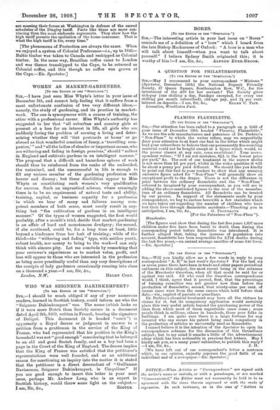FLAMING FLANNELETTE. l'ro MR EDITOR OF TWA " SPECTATOR...I Sia,—Our
attention has been called to a paragraph on p. 1055 of your issue of December 19th headed "Flaming Flannelette." As we are the sole manufacturers and patentees of Dr. Perkins's " Non-Flam" to which the writer refers, may we respectfully draw your attention to at least one fact in the letter which might lead your subscribers to believe that our permanently fire-resisting material could not be bought except at a figure which would, to the poorer classes at any rate, seem exorbitant ? Your corre- spondent writes : "If I am not mistaken, Rd. is the lowest price per yard," &o. The cost of our treatment in the narrow cloths is not more than id. per yard, whilst in the wider qualities it will be about a penny per yard different. We should like you kindly to point out this fact to your readers to show that any seeming excessive figure asked for "Non-Flam" will generally show an exceptional profit to the draper. There is not the difference in price between the ordinary flannelette and the " Non-Flam " referred to imagined by your correspondent, as you will see in adding the above-mentioned figures to the cost of tho manufac- ture of an ordinary flannelette. All flannelette can be treated by our process. In support of the statements made by your correspondent, we beg to enclose herewith a few statistics which we have taken out regarding the number of children who have lost their lives through flannelette accidents.—Thanking you in
(For the Patentees of" Non-Flam ").
Manchester.
[The figures sent show that during the last five years 1,697 more children under five have been burnt to death than during the corresponding period before flannelette was introduced. It is further alleged that, taking the increase of population into account, flannelette has been responsible for 2,714 deaths during the last five years,—an annual average sacrifice of some 540 lives. —En. Spectator.]






































 Previous page
Previous page